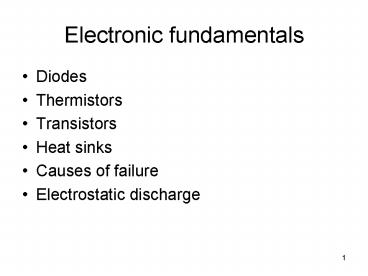Electronic fundamentals - PowerPoint PPT Presentation
1 / 23
Title:
Electronic fundamentals
Description:
... control circuits, and other electronic systems on ... Ideally suited as an electronic voltage regulator. Also used in fuel injector circuits as a clamp ... – PowerPoint PPT presentation
Number of Views:266
Avg rating:3.0/5.0
Title: Electronic fundamentals
1
Electronic fundamentals
- Diodes
- Thermistors
- Transistors
- Heat sinks
- Causes of failure
- Electrostatic discharge
2
Diodes
- Allows current to travel in one direction only
- Used in alternators as part of a rectifier bridge
(group of diodes) to control current flow in one
direction - Also used in computer controls, climate control
circuits, and other electronic systems on the
automobile
3
Diodes
4
Diodes
- Zener diodes a diode that blocks reverse-bias
current up to a certain voltage - Above the breakdown voltage point, a zener diode
will conduct current without damage to itself - Ideally suited as an electronic voltage regulator
- Also used in fuel injector circuits as a clamp
5
Diodes
- Clamping diodes used to suppress high voltage
spikes whenever a coil is turned off - Installed across coil leads to redirect the high
voltage spike back through the coil windings - Commonly used on A/C clutches
6
Zener Diodes
7
Diodes
- Resistors can sometimes be used in place of
diodes for controlling high voltage spikes - Coils often fail shorted rather than open
- This condition results in greater current flow in
the circuit which a diode cannot control - A resistor wired in parallel can reduce spikes if
a coil shorts out - Often found in climate control solenoids
8
Two different methods of spike suppression
9
Diodes
- Light emitting diodes (LED)
- Diodes that radiate light when current flows
through in a forward bias direction - LEDs produce very little heat
- More efficient because energy consumed is
converted directly to light - Faster reacting than incandescent
10
Diodes
- Checking diodes for proper operation
11
Thermistors
- A thermistor is a semiconductor that changes
resistance according to temperature - As a voltage is applied, the resistance drops as
temperature increases - Referred to as NTC negative temperature
coefficient - Commonly used for coolant and intake air
temperature sensors
12
Thermistors
13
Transistors
- A transistor is a semiconductor that will allow
current flow if certain electrical conditions
allow it to switch on - Used on an automobile for the following purposes
- An electrical switch
- To amplify current in a circuit
- To regulate current in a circuit
14
Transistors
- Acts as two back to back diodes that can conduct
current in one direction only - If the base current is turned on, the current
flow from the collector to the emitter can be
turned on or off - The current controlling the base is called the
control current
15
Transistors
16
(No Transcript)
17
(No Transcript)
18
(No Transcript)
19
Heat sinks
- A heat sink is something designed to conduct
damaging heat away from electronic parts - Ribbed electronic ignition control units
- Cooling slits and fan attached to a generator
- Special heat conducting grease applied to modules
mounting bases
20
Causes of failures
- Poor connections
- Heat
- High voltage spikes
- Excessive current
- Improper polarity
- Electrostatic discharge
21
Electrostatic discharge
- Static charges build up on a human body whenever
movement occurs - When a conductive material is touched, the static
charge is rapidly discharged - Can cause severe damage to electronic components
22
Electrostatic discharge
- If you can feel it it is at least 3000 volts
- If you can hear it it is at least 5000 volts
- If you can see it it is at least 10000 volts
23
Electrostatic discharge
- Keep electronic components in protective wrapping
until ready to install - Before handling any electronic component, ground
yourself to a good conductor - Do not touch component terminals

